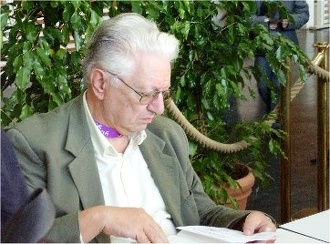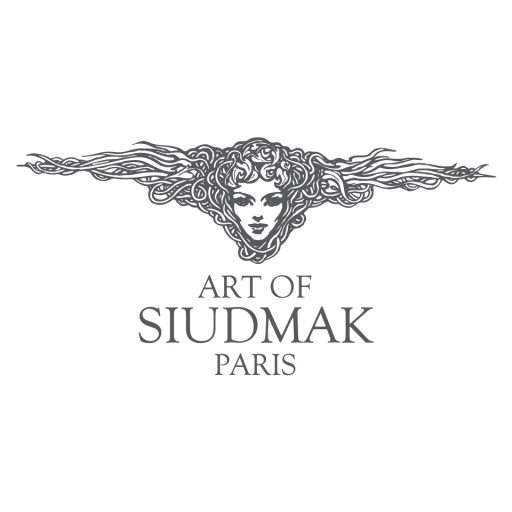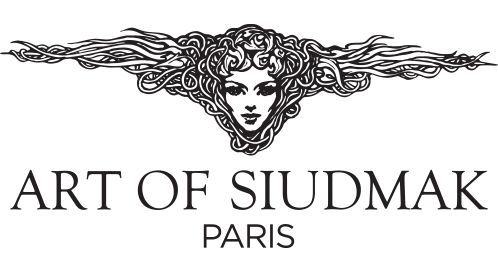Siudmak likes discomfort; he proclaims himself to be a fantastic hyperrealist, a follower of Ingres and Dal..
His position may seem paradoxical, although it becomes quite understandable if one looks at any one of his works. The painting featured on the cover of the present volume is hyperrealistic in the literal sense, because of Siudmak’s impeccable work, because of his unfailing concern to make everything look believable, including what is not real today, because of his obvious desire to convince or, occasionally, to mystify. The painter has chosen a ‘cold’ technique, which conceals the brushwork and enables him to compete with reality. The brushstroke, which signals the illusion and also, in the dominant critical tradition, the Author, is almost invisible. The creator vanishes, offering his sumptuous world to our bemused eyes. There is no Subject behind the artist’s brush – nor even behind our own eyes. These phenomena proceed from the tenets of hyperrealism but, years ago, this was already part of Ingres’ theory. “The brushwork, however skilful, must not be seen; otherwise it destroys the illusion and renders everything motionless. It shows off the painter’s hand rather than showing off the object”.
The similarity with hyperrealism stops here, because for Siudmak technique is only a means to an end. Photographs and, more generally, models ‘once removed’, such as reproductions of paintings from art books, are nothing but props, or launch pads for his inspiration, an inspiration alive with an energy springing from elsewhere. To Siudmak, meticulousness is not a virtue in itself. What matters is the content: the more unusual and disturbing the message, the greater the author’s need to resort to techniques of fascination, or even hypnotism, so as to force a message on the public. It is easy for a competent painter to give reality to their world but there is no point in this unless they give the viewer an extra sense of being.
The exterior world is banal: it is the common property of both the artist and his public. To a painter using a cold technique, the only universe worthy of representation is a universe that not exist or, rather, exists only in the mind. As far back as 1928, Andr. Breton warned: “If the plastic work of art is to answer the need for a total reshaping of values the necessity of which is recognised today by everyone, it should conform to a purely internal model or otherwise it will not exist” (Le surr.alisme et la peinture).
Siudmak here adopts one of the tenets of the Surrealists, more particularly Dal.. Why Dal., when, for instance, Magritte’s ideas often announce Siudmak? Because Dal.’s technique is strikingly more beautiful, because his premeditated classicism results in shock effects which reveal the strength of the ideas and the hallucinatory presence of the impossible. He wants a painting to be a “hand-made colour photograph” of what is in his mind. Andr. Breton can be quoted again: “It is probably because, through painting or other media, the author is able to reproduce, to give an external existence to internal objects the pressure of which he so painfully experiences, that he can to a large extent save himself from succumbing to the tyranny of these objects and falling into actual psychosis” (Le cas Dal.).
Another common ground of Siudmak and Dal. is what the latter has called, somewhat loosely, “paranoid-critical activity”. As a matter of fact, this phrase, which recalls the Surrealists’ attraction to psychoanalysis and delirium, implies a serious distortion of their method. Limits are set to chance and to the powers of the Unconscious, and a new importance is given to interpretation and intellectual construction, both being placed, somewhat arbitrarily, under the banner of paranoia. Dal. writes: “The paranoid critical activity no longer considers surrealist phenomena and images as separate entities but as coherent patterns of systematic and significant relationships” (La conqu.te de l’irrationnel).
It is not for us to decide whether Dal. has ever been paranoid. Siudmak clearly is not. But he is fond of conceptual structures and allegories: through his use of composition, he gives his work a ‘second’ meaning, sometimes a ‘third’ one through the title, and even a ‘fourth’ one when the painting is used to illustrate the cover of a novel, on which he thus opens new perspectives.
As we all know, science fiction is political: it concerns us all, jointly and severally. Science fiction is also cosmic: we are reminded of the truth that man is not the master of the world, that he is forced to confront what is non-human inside and outside himself. Perhaps science fiction is tragedy in a modern guise. Tragedy, Jean Giraudoux said, is “the proclamation of a bond between mankind and a fate superior to man’s fate”. Instead of the ancient gods, the Moirai, The Parcae and Fate, we have bombs, machines, mutants, aliens, robots, time-traps, and all of the ‘possibles’; that our imagination can dream up, as long as they have not been developed by our intellect. Nor should we forget their forerunners: the living dead, monsters, ghosts, demons, sorcerers. The writers of today are readers of Dick, Herbert or Jeury, not of Sophocles, Shakespeare or Racine. Many of them use humour in the Sheckley manner, which is clearly compatible with tragedy. Science fiction is informed by the anxiety of modern times, and Siudmak creates beauty out of this anxiety.
Science fiction, a literature of ideas, has proved more accommodating than realistic or political art to whoever wishes to express our problems through images. A problem can be seen as a local disruption in the order of the world, as a contradiction between two requirements, and a new idea as a connection made between two terms that until then had been kept separate: thus we are not far from collage, the surrealist technique which aims at creating something new out of the sudden telescoping of d.j.-vu elements. It all goes back to the old mythological and pictorial tradition of composite monsters like the Chimera, a paradoxical juxtaposition of parts which, when taken separately, seem perfectly orthodox. Michelangelo, one of Siudmak’s other masters, has written: “When, for the relaxation and recreation of the senses, and for the pleasure of our mortal eyes, which sometimes wish to see that which they have never seen and the existence of which appears impossible to them, a painter introduces a few chimerical beings into his work, he shows more respect for reason than if he introduced the usual figures of man or animals”. The ‘reason’ which is invoked here is close to the ‘reason’ of science fiction which associates ideas only through clusters of images, i.e. separate parts of either the body or the world, in order to raise questions of flesh and blood, to produce precipitates of perplexity, to create objects of doubtful coherence and intense self-assertion. Hyperrealism is around the corner, or rather the interrogation which hovers above hyperrealism: does the world have a meaning? Does it exist?
We can all dream up the impossible. Only artists, Siudmak among them, can make it exist. We keep asking ourselves why God created the Universe. The answer is that he felt like it. Some people have suggested that he created the world so as to be less lonely, an explanation to which little credence is usually given! In Jacques Lacan’s words: “You have no knowledge of the anxiety of what concerns you and does not pay attention to you”. We have no knowledge of our forefathers’ anxiety, we do not see that we were born of their desire, we do not know that we are as necessary and mysterious to them as they are for us. We are their fetishes, we feel meaningless and we do not know that we ourselves are their meaning.
Siudmak paints in the way God created the world: those who care only for romanticism or factuality will not recognize the Promethean impulse behind his work. The impossible object is there, luminous, motionless, and it fascinates because of this very motionlessness. Michel Nuridsany talks about the spell cast by those men and women “waiting as though suspended in amniotic fluid”. The paradox seems even more acute to George Lucas, a master of the moving picture who knows the appeal of the fixed frame, rich as it is with an enigmatic past and an enigmatic future, dead or still unborn on the surface and swarming with life below. Between the movie-maker and the painter the difference is as great as between ‘star peace’ and Star Wars. But, being a master storyteller, Lucas sees that Siudmak’s paintings move somewhere else, whereas a story heads towards an end, a closure. The surprising fact is that the uncanny shows through the academism, the mystery through the transparency. If this is peace, it is an armed peace.
Perhaps Siudmak is misunderstood in the way that Ingres was. Baudelaire, who did not care for him, talked about his “kind of ideal, made half of wholesomeness, half of quietude, close to indifference”. This is the truth, but not the whole truth. In Jupiter and Thetis, Siudmak detects not only grace and harmony but also incredible strength. Ingres can achieve a gigantic effect even in a small drawing. The same goes for Michelangelo or Dal. in the Christ of St John of the Cross. These masters of balance are masters of excess. If they pay so much attention to composition, it is because a force lurks in them, always threatening to undermine structure. If they imitate their models, it is because of an excess of imagination. Baudelaire himself detects in Ingres “an awareness of a fantastical world, or rather of a world that wants to be fantastical”. The corrective ‘wants’ is not without guile, but we have only to recall Magritte’s words: “The art of painting can rightly be called the art of imitation when it consists in painting the image of a thought which is like the world, such likeness resulting from a spontaneous operation of the mind, not from a rational or delirious search for similitudes. And what is imagining a thought which is like the world? Quite simply using the imagination”. We can follow Baudelaire when he says that the imagination ‘wants’ to be fantastical, since it always operates as a mirror, but is endowed with the faculty of giving existence to objects through thinking; that is, of making them like the world. When it makes them exist on a canvas, it creates the world. Such a world is perhaps created only to meet its death, and, (…) to turn us into spectators of its immolation. But this is immaterial, since the evidence of the painting remains: the arabesques are a tidal wave, and the song is a scream. One day, Siudmak felt very lonely, and he became a god.

Jacques Goimard
From Wikipedia, the free encyclopedia

